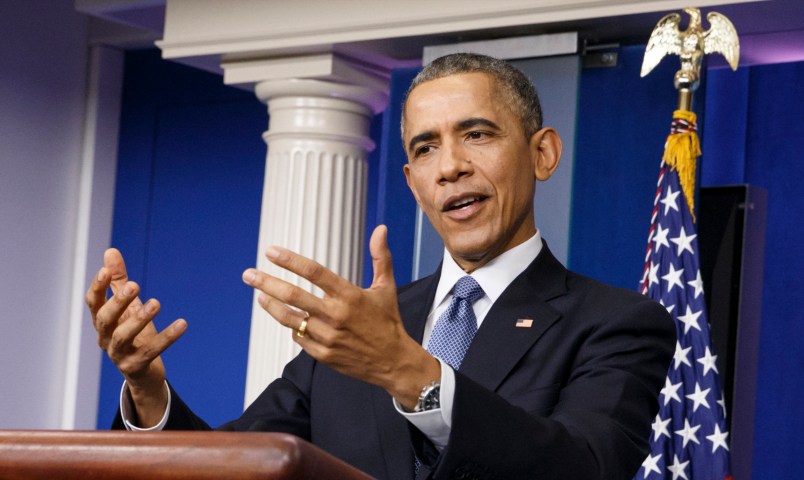This post has been updated to clarify the survey’s findings.
How is this possible? More than one-third of people who are still uninsured under Obamacare — but appear to be eligible for coverage and sought it out — were told that they were not eligible for health insurance under the law, according to a new report.
The finding, from a survey of 10,500 uninsured Americans by the non-profit Kaiser Family Foundation, is truly perplexing. If you extrapolate out to the overall uninsured population in the United States, it means that more than two million people who by the letter of the law should be covered were told that they weren’t qualified.
“I’ve got no possible explanation for you,” Caroline Pearson, vice president of Avalere Health, an independent consulting firm and a top expert on health policy, told TPM. That’s a bit of an exaggeration — she and others had some educated guesses — but it’s not that far off.
Kaiser found that about 48 percent of the estimated 30 million people who remain uninsured were likely eligible for either Medicaid or private insurance subsidies under Obamacare. The rest were ineligible because they made too much money to qualify for tax subsidies or had access to employer-sponsored insurance (17 percent), their immigration status disqualified them (14 percent) or they fell into the law’s coverage gap because their state didn’t expand Medicaid (18 percent).
Of the 48 percent who are eligible for coverage, 41 percent sought it. And of those, 30 percent said that it was still too expensive. Another 33 percent gave another reason, which covers a range of possibilities, including ideological opposition to the law or they didn’t finish their application. But the maddening finding is the 37 percent of eligible uninsured who sought coverage but said they were nonetheless told they didn’t qualify for coverage. The survey didn’t follow up with a question about how they were told they were ineligible.
“It jumped out at us, too,” Larry Levitt, vice president at Kaiser, told TPM in an email.
Two possible explanations came to mind for Pearson and Levitt. One is that some of those people who are eligible for coverage now actually were ineligible when they first tried to apply. The lower a person’s income, the more volatile their income often is. It’s plausible that a chunk of these people had become eligible between the time they applied and the survey, conducted from Sept. 2 to Dec. 15, 2014.
The other is that people misunderstood what they’d been told, whether by the insurance exchange websites, an assistant who helped them try to sign up, etc. The insurance information gap has always been seen as a major challenge to Obamacare.
“People may have been confused about what they were being told,” Levitt said. “Or, they may have been told they were ineligible for marketplace coverage but eligible for Medicaid, or vice versa, and were confused by that or didn’t follow up.”
Some of that responsibility could also lay with HealthCare.gov and the other insurance exchanges. “I think some of the messages for people who appeared to be Medicaid eligible were particularly muddled” in the early days of 2014 enrollment, Pearson said. TPM reached out to administration officials for their take on the Kaiser findings.
But whatever the explanation, it demonstrates a remaining obstacle for Obamacare: Most of the easily enrolled have been swept up in the law’s first two years. Getting through to the rest of the uninsured is the next assignment as the law works toward its goal of near-universal health coverage.







Imagine a world where Democrats didn’t sulk in their rooms or contemplate their navels or whatever the fuck else they were doing in 2010 rather than voting. In that world, we’d have seen a large number of PSA’s on primetime for weeks before and during open enrollment explaining the law and telling them where to find out more.
How can anyone profess to be “surprised” with this and keep a straight face? Who the hell do you think told these folks they were ineligible? The same folks that tell them to vote on Monday. Come on!
Just one little GOP’er in a position to “advise” these people can sand bag 100’s of applications. It’s in their political interests to keep enrollment numbers as low as they can. If these results “surprise” you get out of any position that requires you to deal with them.
Hmmmmmm…
I’ve always thought that the irony of all ironies is that the ACA IS what the GOP is lying about: patient centered, market based health insurance. In essence, it’s the average American that has to take the initiative to get info. on what they’re eligible for and, if not, find out why not. Not just sit back and shrug their shoulders; take the next few steps to find out how can they get insured. And if they STILL can’t get insured, understand that voting is probably the next step in getting their representative to make it happen.
Fox news tells their minions that the ACA (a/k/a/ Obamacare) is socialism. A socialist system doesn’t have to rely on the average person’s stupidity or apathy. Unfortunately, the Democratic Party doesn’t understand that, in many ways, PR is 99% of the game. But the Dems rely on Americans being able to get information, analyze that information and make cogent choices therein. The GOP has never made that mistake about their base.
Casualties of the mistaken belief that more states would set up their own exchanges.